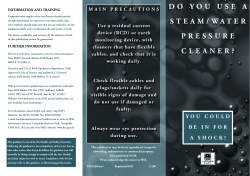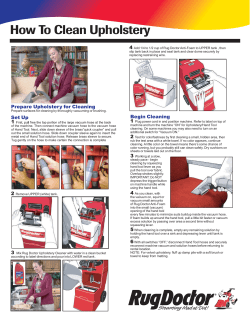
em 4 e a
Health and Safety Executive em4 asbestos essentials Non-licensed tasks This information will help employers and the self-employed to comply with the Control of Asbestos Regulations 2012. It is also useful for trade union and employee safety representatives. Only carry out this work if you are properly trained and have the right equipment. Remember: I Asbestos fibres can cause lung cancer and lung diseases. I Check that the vacuum cleaner is in good working order before you start. Using a Class H vacuum cleaner for asbestos Equipment and method sheet What this sheet covers This sheet describes the Class H vacuum cleaner, how to use it to minimise asbestos fibres released during a task, and how to use it to clean contaminated items. The cleaner must comply with British Standards. Never use domestic vacuum cleaners, even those fitted with HEPA (high efficiency particle arrestor) filters. Equipment I You can hire a Class H vacuum cleaner with a range of attachments; look up ‘asbestos safety equipment hire’ on the internet or see ‘More help’ on sheet a0. I Ensure hired cleaners are clean and in good working order on receipt. I The hire company should thoroughly examine and test the cleaner at least once every six months. They need to be licensed by HSE to do this. Procedures Vacuuming I Pick up bigger pieces of debris and put them in a suitable waste container. I Vacuum clean with care; it is easy to disturb asbestos fibres, make them airborne and breathe them in. I Wet material can damage the HEPA filter. I Clean floors, carpets and fabrics with the adjustable floor attachment. I Clean areas of limited access with the tapered attachment. I Clean solid surfaces such as desk tops with the flat attachment. I Check for damage after use. Caution: Avoid using brush attachments for area cleaning. Brushes are difficult to clean properly. Hire a Class H vacuum cleaner from a licensed hire company and follow all instructions. Make sure it conforms to BS 8520-3:2009 and contains a filter conforming to BS EN 1822. Class H vacuum cleaner 1 of 2 pages Health and Safety Executive MORE HELP I More asbestos pictures – www.hse.gov.uk/asbestos/gallery.htm I Help to decide if work is licensed – www.hse.gov.uk/asbestos/licensing/ index.htm I For information about health and safety, or to report inconsistencies or inaccuracies in this guidance, visit www.hse.gov.uk/. You can view HSE guidance online or order priced publications from the website. HSE priced publications are also available from bookshops. I British Standards can be obtained in PDF or hard copy formats from the BSI online shop: www.bsigroup.com/Shop I These equipment and method (em) sheets and task (a) sheets can be downloaded free from www.hse.gov.uk/ asbestos/essentials/index.htm I See sheet a0 for details of more guidance. Control measures: shadow vacuuming and using plastic enclosures as local extraction Used as a control measure – dust extraction I You can use the Class H vacuum cleaner to control asbestos fibres ‘at source’, eg: - shadow vacuuming: hold the nozzle close to the task (eg screw removal); - local dust extraction at the cutting point; enclose the tool (eg drill bit) with a cowl and attach the nozzle. Possible problems I Reduced suction: - you have a long extension cable, resulting in low supply voltage; - the waste container is full; - the hose has blocked. Clearing it can release asbestos; clear it carefully or get help from the hire company. Emptying and cleaning I Follow the hire company’s instructions for waste disposal. I Never clean inside the vacuum cleaner yourself. I After each use, clean the vacuum cleaner’s outer casing and attachments with the vacuum and then with damp rags. I Inspect the case, hose and attachments visually. I Keep the hose and attachments in a labelled plastic sack. I Replace the sealing cap over the hose opening in the cleaner’s casing. Caution: You, and other people, will be exposed to high levels of asbestos fibres if you fail to take the proper precautions. British Standards You should only hire a Class H vacuum cleaner that conforms to the following standards. For more information on British Standards see ‘More help’. This guidance is issued by the Health and Safety Executive. Following the guidance is not compulsory and you are free to take other action. But if you do follow the guidance you will normally be doing enough to comply with the law. Health and safety inspectors seek to secure compliance with the law and may refer to this guidance as illustrating good practice. asbestos essentials em4 I BS 8520-3:2009 Equipment used in the controlled removal of asbestoscontaining materials. Gives recommendations for the operation, cleaning and maintenance of class H (high hazard) vacuum cleaners containing a filter conforming to BS EN 1822 in the controlled removal of asbestos-containing materials (ACM). It does not apply to any other types of vacuum cleaner for vacuuming up liquids or other applications. This document is available at www.hse.gov.uk/asbestos/essentials/index.htm © Crown copyright If you wish to reuse this information visit www.hse.gov.uk/copyright for details. First published as part of Asbestos Essentials Task Manual 2001. Published by the Health and Safety Executive 04/12 Using a Class H vacuum cleaner for asbestos 2 of 2 pages
© Copyright 2025





















